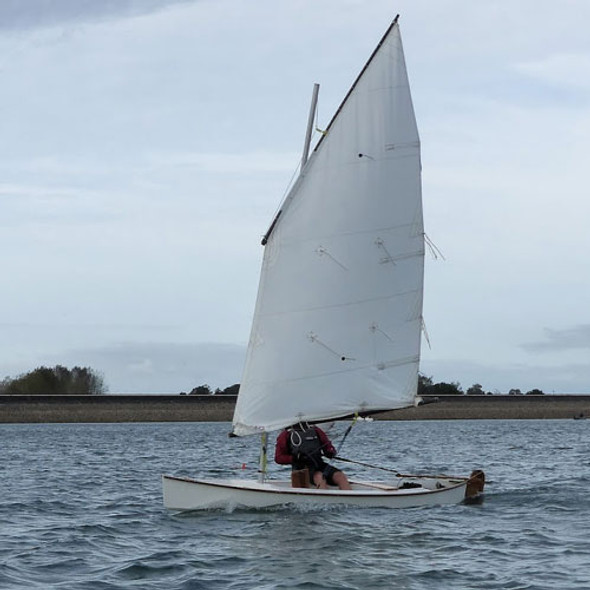Description
DESCRIPTION
ARTEMIS was designed as a solo cruising sailing canoe and as a paddling canoe for two. Brian Pearson (aka keyhavenpotterer) provided so much input that I name him as a co-developer here. ARTEMIS started as a design for myself, to be used on the Lake of Constance, Switzerland, where wind speed and direction would change a couple of times a day, with calms in between. I made the plans (and kits for european customers) available after building and testing several prototypes on the Baltic and the Med. ARTEMIS is a "50-50“ canoe, as easy to paddle as to sail: "Sail when you can, paddle when you must!“
Historic sailing canoes have an impressive number of compelling advantages, features that are just as exciting now as they had been 150 years ago, when the sailing canoe was invented and served as a vector to introduce and promote canoeing and -later- kayaking in Europe.

I wanted reasonable form stability under sail, the ability to hoist and lower the rig on the water, storage for mast, sail and boom in the boat, good seakeeping attitude in a swell, a hull wide enough to camp in, with a tarp overhead, a cartop weight of about 55 to 66 lbs, which is light enough to load her on a roof rack without help, and some luggage capacity for a fortnight's cruise with lightweight camping gear, to name a few. Good planing ability, at least when the boat is empty, on a beam or broad reach. Rudder action as easy as holding a pencil. And an ingenious seat, fully adjustable, engineered to paddle and sail the whole day in as much comfort as you would have in a car. Building technique should be simple stitch & glue.
Some ARTEMIS builders have owned a couple of boats before, most of them bigger and/or faster, but always much more expensive. Now, the builders are downsizing to something more manageable, less complex: more fun at less cost. They know that -well- a big boat is a big problem, and a small boat is a small problem, and they know that a sailing canoe is among the easiest and most versatile boats you can build and own. Reduced trip preparation time and instantaneous availability translate into more time on the water. It is a fascinating concept: launch her nearly anywhere, just take with you what you really need, and off you are for short excursions of a few hours or cruising up to 2 weeks. I am using ARTEMIS much more often than any other boat I have owned, because she is so easy to use.
Cruising in comfort is important, and first of all depends on your seat. The fully adjustable seat is an offspring of Hugh Horton’s very clever seats for his sailing canoes, simplified for easy building. I have used that seat model for about 1,000 km now and there is nothing I would change. ARTEMIS can be sailed from within the cockpit –just reef if the wind pipes up- or hike out on the side deck and have a wild and wet ride.
A boat that is going to be paddled efficiently, with either a double-blade or single-blade paddle, is necessarily a boat with low resistance, because human propulsion forces are weak. Add this to the requirement that she should be able to plane, in a good breeze, then you understand that hull form and foils development took some time for trial-and-error, to maximize performance. This is definitely not your average canoe hull shape.
The whole interior is completely open. The cockpit is wide and long, for good access to the whole interior, and for sleeping within the boat. I have built two pretty wave bords, to close parts of the cockpit, but other builders have been much smarter and are using tarpaulin dodgers.
Several rig/sail options from 44 to 65 sq ft are tested and available:
- The 5,2 sqm Hugh Horton Bufflehead sail with its carbon rig is of superior quality and efficiency. It is fully battened, so has a perfect shape even in very light wind, can point very high and go fast, and is therefore used for big cruises and regatta sailing
- The 44 sqft Solway Dory bermudan sail with its aluminium rig is very easy to reef and is the right rig for fast changing conditions and jointly cruises
- The 5 sqm MacGregor main lugsail with its carbon mast and its woden rig is a good all-round sail with an outstanding price-to-benefit ratio.
Safety is important. With some pool noodles under her side decks and inflatable buoyancy bags in bow and stern, it is easy to recover ARTEMIS from a capsize, get back into the cockpit, bail her out and carry on.
Building ARTEMIS is suitable for a first-time builder. The plans consists of 15 sheets and include a detailed list of materials and a CD with a comprehensive 40-page building key with lots of photos, giving detailed information on each building step, how to join plywood, how to mark the shapes of the panels, and how to use epoxy. Some builders have added outriggers. She is designed to not need them, but will take them with grace.
PARTICULARS
SAILING CANOE, 15'11" X 30", 55 to 66 POUNDS CARTOP WEIGHT
Kits available at:
https://www.bootsbaugarage.ch/
Artemis building instructions
https://www.bootsbaugarage.ch/












